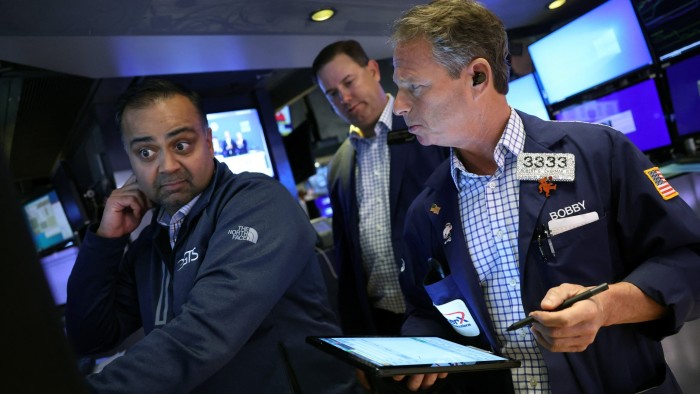Latest news on ETFs
Visit our ETF Hub to find out more and to explore our in-depth data and comparison tools
Fund managers that have converted out-of-favour mutual funds into exchange traded funds are typically being rewarded with a jump in inflows, according to research by Bank of America.
The trend, which has seen 121 actively managed US funds with total assets of $125bn switch structure in the past five years, offers hope to under-fire active managers that have seen persistent outflows in recent years as investors have increasingly adopted low-cost index-tracking funds.
“It’s a pretty remarkable result,” said Jared Woodard, investment and ETF strategist at BofA Securities. “We have been watching this quietly over the past couple of years as more and more funds have made the change, but you have to wait and see what happens after the conversion.
“On average, for the issuer, it clearly looks like a winning move. I wouldn’t be surprised to see the trend of these mutual fund to ETF conversions continue to accelerate when you see the success that others have had,” Woodard added.
Since 1993, when the first ETF was launched, investors have pulled out a net $5.5tn from US-domiciled active equity mutual funds, according to data from EPFR, with that trend accelerating in recent years.
In contrast, passive equity ETFs have sucked in net inflows of about $4.5tn over the same period as investors have increasingly embraced not just cheap index funds but also the ETF structure that brings with it greater transparency, liquidity and tax efficiency, as well as, in most cases, lower fees.
Jumping on the ETF bandwagon by converting mutual funds appears to offer active managers the chance to ride at least part of this wave.

BofA analysis of the 121 conversions to date found the average fund had suffered $150mn of net outflows in the two years prior to conversion, but enjoyed $500mn of inflows in the two years after the switch.
This “ETF advantage” was evident both for funds that beat their benchmark and those that failed to do so, with the average underperforming fund seeing inflows equivalent to 1.3 per cent of assets per month.
Most asset managers have chosen to swallow fee cuts as part of the conversion process, though, effectively bowing to the unwritten convention that ETFs are cheaper than comparable mutual funds.
The US funds that have converted had an average total expense ratio of 90 basis points prior to conversion, but 60bp afterwards, BofA found. Even this left them pricier than the average active ETF, which sits at 40bp.
Despite the fee cut, though, the bank found that rising assets as a result of inflows meant conversions could be revenue positive within “as little as 12 months”.
“Even amid intense competition in the ETF market, we find that the average ETF gains enough in flows to offset a lower fee base,” Woodard said.
Bryan Armour, director of passive strategies research, North America at Morningstar, sounded a note of caution, however.
He noted that, according to Morningstar’s figures, $32bn of the $35bn of net inflows vacuumed up by conversions were grabbed by seven funds switched by Dimensional Fund Advisors in 2021.
The Texan titan’s septet are all among the eight largest conversions of all time, interrupted only by the JPMorgan International Research Enhanced Equity ETF (JIRE), at number five.
“Dimensional ETFs are doing a lot of the heavy lifting in this research,” Armour said. “Overall the results are more mixed, but still that’s positive compared to mutual funds. Anything is better than that [but] it’s not a panacea. It’s not like everyone who launches an ETF is in inflows.”
However, Woodard argued that “the conclusion was just as strong”, when Dimensional was removed from the equation.
The number of US fund conversions has risen every year since 2021 and Woodard believed this could continue, particularly given that several more impending conversions have already been announced.
To this end, BofA scoured the ranks of America’s 7,000 or so mutual funds. It found about 400 “that are experiencing outflows but also had strong returns and were outperforming their benchmark”.
Woodard believed these “funds that had been doing well but haven’t been rewarded for it, in terms of investment flows,” were ripe for conversion. “As the market becomes more competitive, managers with assets under pressure may decide to convert while they still can,” he added.
Armour was more circumspect. He believed active ETFs in general were a success story (they bagged a record 27.9 per cent of net inflows to all US-listed ETFs in the first 10 months of 2024, despite only accounting for 8.1 per cent of assets, according to Morningstar).
However, Armour said conversions were not the only way in, with some asset managers launching ETF clones of their mutual funds instead.
He added that an ETF conversion would be difficult for funds that are widely used in 401k pension vehicles, given that many retirement platforms are not set up to handle ETFs. 401k assets are also tax exempt, erasing any tax-related benefits of conversion.
An alternative approach would involve aping Vanguard by launching an ETF as a share class of a mutual fund, a structure at least 33 fund groups have filed with the US Securities and Exchange Commission to create since the expiry of Vanguard’s patent.
If this was approved, Armour believed it “could be a game-changer that would make it easier for asset managers to get the best of both worlds” by operating both fund structures in tandem — and exporting the tax efficiency of the ETF to its sister mutual fund, as Vanguard can do now.
https://www.ft.com/content/a4444ec5-4e0f-4028-80ff-502cc0c3d292


